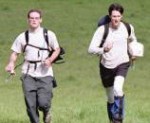Date: Nov. 4 - 5, 2006
Location: Livermore, CA
Event Directors: - 925.516.7622, - 925.516.7622
Course Setters: Martin Kunz, Hannu Haarma
Type: A; 2-day event, with separate results for each day
Note: See the Event Directors' Notes for information about the terrain, maps, courses, Start and Finish locations, Start procedure, hazards, safety, and more.
Note: Be sure to plan ahead for the time it will take you to get to the Start area. On Saturday, there is a 1.8-km walk to the Start area for the advanced courses. On Sunday, there is a 3-km shuttle ride (frequency unknown) and a 200-m walk to the Start area for the advanced courses.
Skip to the Course Setter's Notes for Sunday
Course Setter's Notes for Saturday
By Hannu Harma
The Saturday courses have been designed to take advantage of the best areas of the Morgan Territory map. All courses will stay mainly on top of the ridge so the climb is smaller (less than 5%) than it is normally here in Bay Area. I have designed the courses to be technical short courses. All courses have more controls than normally. Most of the controls are either boulders or dead trees (either totally fallen or still partially standing). The white forest is quite fast to run and there are only a few areas of light and dark green. Light green slows you down, and dark green is good to avoid — it can be thick Manzanita forest or thick smaller bushes. There are many boulders and boulder fields in some parts of the map, so be careful when you run thru them. The trail network is quite heavy, but courses have been designed to avoid them as much as possible, except in some cases the trails may provide a safer route choice. Although the courses are technical, there are almost always some major features close by where you can get back to "the map" if you have found yourself wandering around many similar boulder formations or you have lost the "touch to the map". The soil is quite hard due to lack of rain. I have tried to avoid areas of poison oak, but you can find PO in some lower ravines, so be careful.
Course Setter's Notes for Sunday
By Martin Kunz
Morgan Territory is a very typical Northern Californian terrain: More or less steep hills separated by deep valleys, carrying some moderately steep ridges, some of which have rather technical and fine topographic features. Much of the terrain consists of the typical golden Californian grass hills, decorated with picturesque oak trees and oak groves. Sunday's advanced courses will lead you through some more remote and less-used areas of the map. To do this, the advanced course will have a remote start, about 3 km north from the assembly area and Finish. Since the parking lot (and thus assembly area and Finish) is pretty much at the highest point of the map, this means that the advanced courses have a bit more climb than usual. (But then again, we all know that this is much better for your feet and knees!!)
The northern part of the map, where the start of the advanced courses is situated, is in many ways a very "Swiss" terrain, which coincides well with the very Swiss course setter. Sunday's race in Morgan Territory will thus be quite different from Saturday's event, despite sharing not only the map, but also a significant amount of the terrain. While Saturday's courses are technical in the sense that one is constantly challenged in terms of fine orienteering, the challenge of Sunday's advanced courses will be route choice and its execution. There are often at least two quite different routes available, and success on these courses will be determined by whether you are able to select the route best suiting your physical strengths. The routes tested turn out to be surprisingly similar, although on long legs differences of cleanly executed routes can amount to minutes. It is well possible that — depending on the runner's physical abilities, e.g. strong hill runner vs. fast flat runner — not the same route is fastest for different runners. The terrain is in general open, very runnable and thus fast. Bear in mind, though, that most of the open terrain is also frequented by cows, which leave their traces in the form of deep holes. Therefore, if the ligaments and tendons of your feet have the elasticity and strength of "your grandfather's underwear" (quote from the course setter's orthopedist), then a strong ankle tape is highly recommended. There is some poison oak, which in this season is difficult to spot due to having lost their leaves.
The White and Yellow courses stay on the flat, mostly open ridges in the south of the map, where they make use of its hiking paths and trails. They use a separate Start, close to the Finish, in order to optimally use the trail network for these less-technical courses. While the White course always has a clear "hand-rail" in the form of a trail, some routes on the Yellow course allow for a more direct, but also more technical route.

